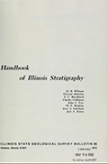Historical:Fort Atkinson Limstone
Lithostratigraphy: Maquoketa Shale Group >>Fort Atkinson Limstone
Chronostratigraphy: Paleozoic Erathem >>Ordovician System >>Cincinnatian Series >>Richmondian Stage
Allostratigraphy: Tippecanoe Sequence
Authors
H. B. Willman and T. C. Buschbach
Name Origin
The Fort Atkinson Limestone (Calvin, 1906, p. 60, 98), the "middle limestone" formation in the Maquoketa Group, is named for exposures at Fort Atkinson, Winneshiek County, Iowa.
Other Names
The Fort Atkinson Limestone has been called the Divine Limestone (Lamar and Willman, 1931) and the "middle limestone" (DuBois, 1945).
Correlation
The Fort Atkinson Formation correlates with the Waynesville Limestone in Ohio and Kentucky.
Extent and Thickness
The Fort Atkinson Formation is exposed in northeastern Illinois, particularly at Wilmington, Will County (SE SW NW 25, 33N-9E) and near the Dresden Island Dam, Grundy County (SE NE NW 34, 34N-8E). It is widely distributed in subsurface in Illinois and is commonly 15-40 feet thick.
Description
In some areas, for instance in much of the Maquoketa outcrop area in northwestern Illinois, the Fort Atkinson becomes very shaly and is inseparable from the shales above and below. In other areas it includes limestone laterally equivalent to the shale formations above and/or below. The Fort Atkinson changes within short distances from white or pink, coarse-grained, crinoidal limestone to brown fine-grained dolomite or gray argillaceous limestone. In some localities the upper part is limestone, the lower part dolomite. The amount of interbedded shale varies greatly.
Fossils
The Fort Atkinson is generally fossiliferous with a large fauna of brachiopods and bryozoans (Savage, 1925a).
References
CALVIN, SAMUEL, 1906, Geology of Winneshiek County: Iowa Geological Survey, v. 16, p. 37-146.
DUBOIS, E. P., 1945, I. Subsurface relations of the Maquoketa and "Trenton" Formations in Illinois: Illinois State Geological Survey Report of Investigations 105, p. 7-33.
LAMAR, J. E., and H. B. WILLMAN, 1931, High-calcium limestone near Morris, Illinois: Illinois State Geological Survey Report of Investigations 23, 26 p.
SAVAGE, T. E., 1925a, Correlation of the Maquoketa and Richmond rocks of Iowa and Illinois: Illinois Academy of Science Transactions, v. 17, p. 233-247.
ISGS Codes
| Stratigraphic Code | Geo Unit Designation |
|---|---|
